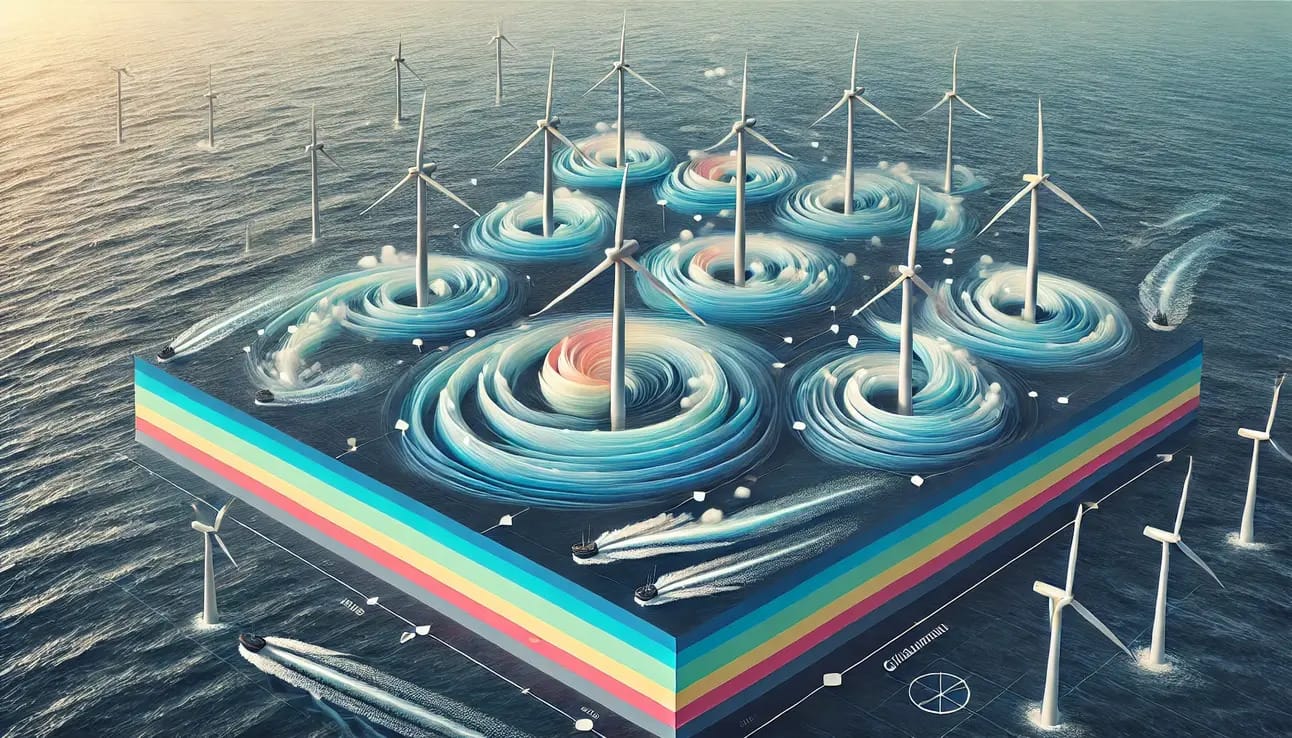- Green Glow
- Posts
- 🌱 What Is the Wake Effect? The Hidden Challenge Facing Offshore Wind Farms ⚠️🌊
🌱 What Is the Wake Effect? The Hidden Challenge Facing Offshore Wind Farms ⚠️🌊
What is the wake effect in offshore wind farms? Discover how wind turbines can interfere with each other’s performance, why the wake effect is a growing challenge in places like the North Sea, and what solutions engineers are exploring.
Find out why 1M+ professionals read Superhuman AI daily.
AI won't take over the world. People who know how to use AI will.
Here's how to stay ahead with AI:
Sign up for Superhuman AI. The AI newsletter read by 1M+ pros.
Master AI tools, tutorials, and news in just 3 minutes a day.
Become 10X more productive using AI.
Offshore wind energy is booming, hailed as a key pillar of the global clean energy transition. But as wind turbines proliferate across oceans, a less visible problem is quietly disrupting the flow: the wake effect. This aerodynamic phenomenon is increasingly putting wind farms—and their energy output—at odds with each other.
Let’s unpack what the wake effect is, why it's a growing concern, and what we can do about it.
Table of Contents

What Is the Wake Effect?
Imagine you're standing behind a large building on a windy day. The breeze is strong everywhere else, but right behind the building, it’s strangely calm and turbulent. The same principle applies to wind turbines. When a turbine spins, it extracts energy from the wind, leaving behind a trail of slower, more turbulent air. This is known as the wake.
When another turbine is placed downwind in that wake, it receives less wind energy, causing its performance to drop. In some cases, output can fall by 20% to 40%—a massive hit for a multi-million-dollar energy asset.
Why Offshore Wind Is Especially Vulnerable
The wake effect is present in both onshore and offshore wind farms, but it's more acute offshore for two main reasons:
More Space, More Turbines: Offshore farms are getting larger, often hosting dozens or even hundreds of turbines.
Prevailing Winds: Consistent wind directions over the ocean make it more likely for turbines to be caught directly downwind of others.
With more countries racing to deploy offshore wind projects—especially in shared waters like the North Sea—the risk of wakes overlapping is becoming unavoidable.
The North Sea Wake Wars
A recent dispute in the North Sea has brought the issue into sharp focus. Wind farm operators are finding that newer neighboring projects can reduce the efficiency of older ones by disrupting wind flow. With so many wind farms planned in close proximity, it's becoming harder to maintain optimal spacing.
These wake-related conflicts are creating tension—not just among private developers, but also between countries. After all, when a new wind farm reduces the performance of an existing one, someone is losing millions in potential revenue.
The Science Behind It
Here’s a simplified look at the physics:
As air flows through a turbine’s rotor, it slows down and becomes turbulent.
This wake can stretch for 10 to 15 rotor diameters downstream—several kilometers in the case of modern mega-turbines.
The turbulence and wind speed deficit recover slowly over distance, meaning turbines further back remain in compromised conditions.
The impact isn’t just on performance. Wake turbulence also increases mechanical stress, potentially shortening the lifespan of downwind turbines.

Can the Wake Effect Be Solved?
Yes—and engineers, scientists, and policymakers are actively working on solutions. Here are a few:
1. Smarter Wind Farm Layouts
Designing farms in staggered formations or optimizing turbine spacing can reduce wake overlap. Advanced modeling tools help simulate airflow and optimize layout before construction.
2. Wake Steering
This involves deliberately yawing (tilting) turbine blades slightly to redirect the wake away from neighboring turbines. Though it reduces the performance of the yawed turbine slightly, it can boost overall farm output.
3. Cross-Border Planning
In densely packed regions like the North Sea, international cooperation and shared zoning plans can help manage wake interference between national projects.
4. Floating Wind Farms
As floating turbine technology matures, it could allow greater flexibility in placement, avoiding wake-heavy zones more easily.
Why This Matters
As we build toward a net-zero future, every kilowatt of clean energy counts. If wake effects go unmanaged, they could undermine the efficiency—and economics—of entire offshore wind zones. More urgently, they could lead to legal and geopolitical friction in contested waters.
Understanding and addressing the wake effect isn’t just a technical challenge—it’s central to making offshore wind energy sustainable, efficient, and collaborative.

Conclusion
The wake effect may be invisible, but its consequences are tangible. Like traffic jams in the sky, these wind shadows are a growing concern as we race to deploy more turbines. The solution? Better science, smarter design, and above all, working together.
FAQs
What is the wake effect in wind energy?
The wake effect occurs when wind turbines reduce wind speed and increase turbulence for turbines located downwind. This leads to a drop in energy output and higher mechanical stress on the affected turbines.
Why is the wake effect more serious offshore than onshore?
Offshore wind farms typically have more turbines placed in large, open areas with consistent wind directions. This makes it more likely for wakes to persist and impact other turbines.
How much energy can be lost due to the wake effect?
Turbines affected by wake conditions can lose 20% to 40% of their potential output, depending on layout, spacing, and wind direction.
What’s happening in the North Sea with wake effects?
In the North Sea, disputes are emerging as new offshore wind farms are found to interfere with the performance of older ones due to overlapping wake zones. This has raised concerns about planning and cross-border coordination.
How can the wake effect be reduced or managed?
Solutions include smarter turbine placement, advanced modeling, “wake steering” (tilting turbines to redirect wind flow), international planning agreements, and using floating platforms for more flexible layouts.
You May Also Like
External Links
Follow Us:
X: https://www.x.com/greenglownews
Youtube: https://www.youtube.com/@greenglownews
Instagram: https://www.instagram.com/greenglownews
Sponsored Links

